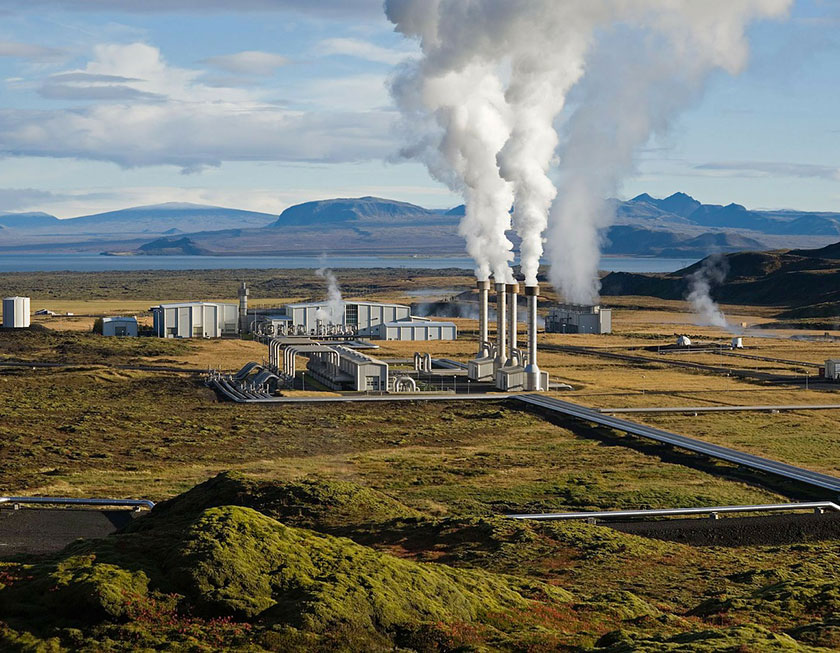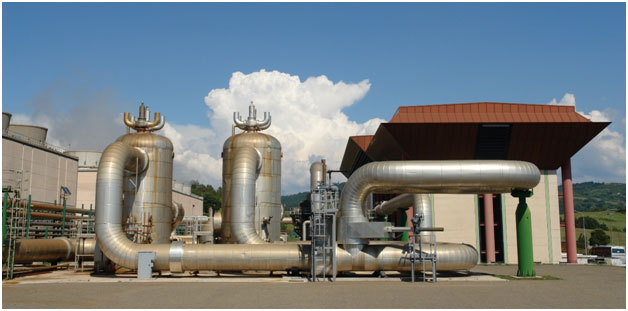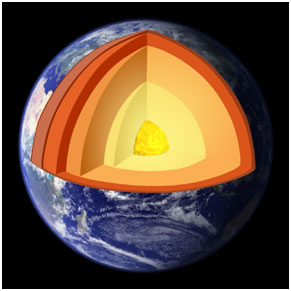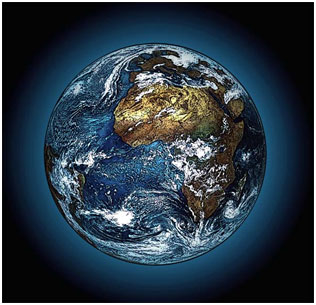Origin of renewable energy sources [ctd.]

1.9 Geothermal energy
We have already discussed almost all the indirect solar energy sources which are unremittingly being replenished by the Sun. In this article, let us discuss another source of renewable energy. Geothermal energy!

Figure 1: A geothermal plant
Geothermal energy is a renewable source of energy. Just like any other renewable energy source geothermal energy is also naturally being replenished.
However, geothermal energy is not being replenished by the Sun! That means… Geothermal energy represents neither an indirect solar energy source nor direct solar energy source.
So….?
Geothermal energy: Where does it originally come from?
If geothermal energy is not being replenished by the Sun, where does it come from?
Is it really a renewable source of energy?
Well….
It is well known that earth’s interior is a huge heat reservoir with an incredible amount of energy in the form of heat!
This energy predominantly comes from two natural processes.
1. Formation of the earth (Primordial heat)

Figure 2: Earth’s layered structure
The entire solar system was formed from a solar nebula made of dust and gasses. After the Sun was formed, the remaining materials collapsed into planets, moons, comets and asteroids due to the gravitation. During the gravitational collapse of the Earth, an enormous amount of gravitational energy/ kinetic energy of collapsing particles/ debris was converted into heat which is now technically referred to as primordial heat of the Earth.
A substantial amount of the primordial heat still persists at the core of the Earth. This heat flows towards the Earth’s surface by conduction and radiates into the outer space thus causing the Earth to cool down with time
2. Decay of radioactive isotopes (Radiogenic heat).
Earth is a warehouse approximately to about three hundred isotopes. Some of them are stable whilst others are unstable (radioactive). As we know, radioactive isotopes decay into lighter nuclei releasing energy according to the Einstein’s equation. Long ago, Earth had had numerous radioactive isotopes which have released a vast amount of energy as they decay. Long-lived radioactive isotopes such as 4019K, 23292Th, 23592U and 23892U [1] still play a crucial role pumping heat continuously to the Earth at a rate of 30 TW [2].
So… The Earth can be treated as a nuclear reactor with a capacity of 30 TW!
A huge natural nuclear power plant! It is fueled by several long-lived isotopes such as , 4019K, 23292Th, 23592U and 23892U .
It is power capacity (30 TW) is equivalent to 30 000 nuclear power plants each with a capacity of 1000 MW!
Long-lived radioactive isotopes would keep pumping enough heat for several billions of years. Therefore, geothermal energy is a renewable source of energy.
Thermal energy comes from the above-mentioned mechanisms can be directly used for space heating or to produce steam which can be then used to generate electricity.
From the Earth → into the space……
The Earth’s temperature should have been rising with time as the radiogenic activity has been generating heat at a tremendous rate of 30 TW!
Earth is, however, a cooling planet!
It has already cooled down to create a habitable home-planet which was an inferno at the beginning. It will be further cooling down with time.
How does it happen?
Well…
As we know, heat is transferred from one place to another via three different mechanisms: Conduction, convection, and radiation.
Any object whose temperature is higher than 0 K radiates its thermal energy in the form of electromagnetic waves into its surrounding. Meanwhile, it would be absorbing radiation from its surround if its surrounding temperature is higher than 0 K. The rate at which an object radiates its thermal energy is proportional to the fourth power of the absolute temperature of the object. Similarly, the rate at which the object absorbs energy from its surrounding is proportional to the fourth power of the surrounding absolute temperature.
An object would be cooling if the object’s temperature is higher than that of its surrounding. The higher the temperature difference the higher the rate at which the object loses its thermal energy.
What about the Earth and its surrounding?

Figure 3: Planet Earth with its atmosphere
Earth’s average surface temperature is 287 K (140 C) [3] while the temperature of the empty space is 2.7 K [4]. The temperature of the space nearby the Earth is, of course, much higher than 2.7 K. But it is still much lower than 287 K. As a result, the Earth has been losing its thermal energy leading to a cooling planet where billions of people and millions of other species live.
The average heat loss from the earth is estimated in the range of 43-45 TW [5]. In other words, our planet Earth is losing its geothermal energy at a rate of 43×1012 J per second (at the lowest scenario).
Yes! It is equivalent to 43 000 000 000 000 J/s.
Moreover, it is nearly 2.5 times the current global energy demand (17.5 TW) and would be higher than the entire energy demand even by 2050 (25-30 TW) [6, 7]. But it is important to realize that none of the technology will be able to harness the entire amount of heat which reaches the Earth’s surface.
The worldwide geothermal electricity capacity in 2015 was estimated at 12.6 GW [8]. As we can see, it is insignificant compared to the rate at which Earth is losing its heat. The lower limit of the geothermal electricity potential is estimated at 50 GW while the upper limit is estimated to be in the range of 1-2 TW [5].
The table below shows the cumulative geothermal electricity generation capacity in several countries.
| Country | Capacity (MW) |
| USA | 3450 |
| Philippines | 1870 |
| Indonesia | 1340 |
| Mexico | 1017 |
| New Zealand | 1005 |
| Italy | 916 |
| Iceland | 665 |
| Kenya | 636 |
| Japan | 520 |
| Turkey | 407 |
| Costa Rica | 207 |
| El Salvador | 204 |
Table 01: Installed geothermal electricity generation capacity as of 2015 [8]
Some other facts about geothermal energy
Currently, geothermal energy is being used
- For district heating and for other applications in 70 countries [9]
- To generate electricity in 24 countries [10]
- Iceland is a frozen land situated on a volcano! The country with a population of 300 000 meets 87% of its space heating requirement and 17% of its electricity demand with geothermal energy [11, 12] thanks to its geothermal resources.
Geothermal energy: Cons and pros
Advantages
- Renewable
- Provides an uninterrupted, regular supply of heat. Therefore, geothermal electricity can be used as a base load power source.
- Residual heat of the steam after generating electricity can be used for district heating or industrial applications.
Disadvantages
- High initial cost
- Some toxic materials such as mercury, antimony, and arsenic may come out with hot water from the geothermal sources.
- Geothermal plants often release various greenhouse gases and also some other harmful gases like radon (A radioactive gas). Hence, geothermal energy is not a carbon-neutral energy source and intensifies the greenhouse effect and climate change. In addition, some of such gases lead to acid raining. However, negative environmental effects of geothermal plants are less significant in comparison with those of coal-powered power plants.
- Most of the geothermal sources are neither technically nor economically viable.
- Potential geothermal energy sources are extremely limited and not readily available.
- Geothermal energy sources are exclusively site-specific. It is not a viable source of energy in most of the regions in the world.
- As mentioned earlier, the maximum geothermal electricity generation capacity has been estimated to be in the range of 1-2 TW. It would be merely 3.1% of the global energy demand by 2100 (global energy demand by 2100 would be 63 TW) [6]. Furthermore, it would require a substantial amount of capital investment and advanced technology to reach the upper limit of 2 TW from geothermal energy.
-
Barbier, E. (2002). Geothermal energy technology and current status: an overview. Renewable and sustainable energy reviews, 6 (1-2), 3-65.
-
Michaelides, E. E. (2012). Entropy production and optimization of geothermal power plants.
-
Jones, P. D., New, M., Parker, D. E., Martin, S., and Rigor, I. G. (1999). Surface air temperature and its changes over the past 150 years. Reviews of Geophysics, 37(2), 173-199.
-
Fixsen, D. J. (2009). The temperature of the cosmic microwave background. The Astrophysical Journal, 707(2), 916.
-
Stefansson, V. (2005, April). World geothermal assessment. In Proceedings of the world geothermal congress(pp. 24-29).
-
Hu, A., Levis, S., Meehl, G. A., Han, W., Washington, W. M., Oleson, K. W., and Strand, W. G. (2016). Impact of solar panels on global climate. Nature Climate Change, 6 (3), 290-294.
-
Blanco, J., Malato, S., Fernández-Ibañez, P., Alarcón, D., Gernjak, W., and Maldonado, M. I. (2009). Review of feasible solar energy applications to water processes. Renewable and Sustainable Energy Reviews, 13 (6), 1437-1445.
-
Bertani, R. (2016). Geothermal power generation in the world 2010–2014 update report. Geothermics, 60, 31-43.
-
Fridleifsson, I. B., Bertani, R., Huenges, E., Lund, J. W., Ragnarsson, A., and Rybach, L. (2008, January). The possible role and contribution of geothermal energy to the mitigation of climate change. In IPCC scoping meeting on renewable energy sources, proceedings, Luebeck, Germany(Vol. 20, No. 25, pp. 59-80). Citeseer.
-
Holm, A., Blodgett, L., Jennejohn, D., and Gawell, K. (2010). Geothermal energy: international market update. Geothermal energy association, 7.
-
Ragnarsson, Á. (2003). Utilization of geothermal energy in Iceland. 000599234.
-
Bertani, R. (2007). World geothermal generation in 2007.
-
By T. AGEMAR – Own work, CC BY 4.0, https://commons.wikimedia.org/w/index.php?curid=56501672
-
By CharlesC (Own work composite) [CC BY-SA 3.0 (https://creativecommons.org/licenses/by-sa/3.0) or GFDL (http://www.gnu.org/copyleft/fdl.html)], via Wikimedia Commons
-
By No machine-readable author provided. Heikenwaelder assumed (based on copyright claims). – No machine-readable source provided. Own work assumed (based on copyright claims), CC BY-SA 2.5, https://commons.wikimedia.org/w/index.php?curid=733587
